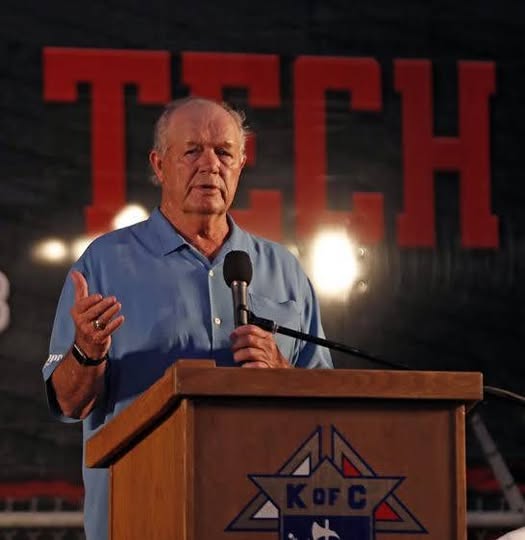In a moment that transcends sport and reaches deep into the heart of legacy, ESPN has confirmed that NFL legend Donny Anderson will return to his roots one final time to pay his last respects to the college that molded him—his beloved boyhood institution, Texas Tech University. For those who know Anderson’s story, this is not merely a ceremonial appearance. It is a symbolic return to the soil that nurtured a prodigy, to the field where a young man once danced with destiny, and to a campus that gave the world one of the most versatile players to ever wear an NFL jersey.
Donny Anderson is not just a name in the vast archive of professional football history; he is a symbol of an era, an embodiment of grit, and an architect of moments that shaped how the modern running back is understood. He was the first-round draft pick of the Green Bay Packers in the legendary 1965 NFL Draft, taken with what was then known as a “future pick.” The selection itself was historic, as it occurred before Anderson had played his senior season at Texas Tech. Such was the magnitude of his potential that Vince Lombardi and the Packers organization were willing to bet the future on a player yet to finish his collegiate journey.
And now, decades later, Anderson returns not as a student-athlete or rising prospect, but as a decorated football titan coming home to honor his origins. According to ESPN, the gesture will be a deeply personal one. There will be no major press conference, no elaborate ceremony with excessive fanfare. Anderson wants it simple—just him, the field, and a chance to say thank you to a place that changed his life.
Texas Tech and Donny Anderson are inextricably linked. Born in Borger, Texas in 1943, Anderson became a statewide sensation during his high school years, drawing attention for his athletic ability and sheer football intellect. His decision to attend Texas Tech proved to be a match made in gridiron heaven. At Tech, Anderson carved out one of the most impressive collegiate careers in the history of the Southwest Conference. A true all-purpose back, he excelled at running, receiving, punting, and returning—often dominating all facets of the game in a single afternoon.
Between 1963 and 1965, Anderson rushed for over 2,000 yards, caught more than 80 passes, and amassed an astounding all-purpose yardage total. In the 1965 season, he was a consensus All-American, putting up over 1,000 yards from scrimmage and leading the Red Raiders to a top-tier bowl game. Perhaps what made Anderson so unique was his vision—both on the field and of his future. He knew he could do it all, and he didn’t shy away from proving it.
His college dominance caught the eyes of NFL scouts, and in 1965, the Green Bay Packers—already a powerhouse under legendary coach Vince Lombardi—used their prized draft capital to acquire him. It was a move that would pay dividends for years. Anderson joined the Packers during the twilight of the Lombardi era and quickly became an essential cog in the machine. By the time he suited up professionally in 1966, he was ready, both physically and mentally, to embrace the challenges of the National Football League.
Anderson played a pivotal role in the Packers’ back-to-back championship campaigns, which culminated in victories in Super Bowl I and Super Bowl II. During that span, he became a prototype for the modern halfback, particularly as a pass-catcher. While most backs in the 1960s focused solely on rushing duties, Anderson was ahead of his time. He could run between the tackles, bounce outside, block in pass protection, and serve as a legitimate receiving threat out of the backfield—essentially creating the mold for what we now recognize as a dual-threat back.
He also contributed as a punter, often pinning opponents deep and controlling field position in an era when special teams strategy could swing entire games. In fact, Anderson led the NFL in punting average during multiple seasons, proving that his utility was not just a footnote but a vital part of his professional arsenal. Over his NFL career, which included productive years with both the Packers and the St. Louis Cardinals, Anderson compiled over 4,600 rushing yards, nearly 3,000 receiving yards, and 56 total touchdowns. More than just statistics, however, his legacy lies in how he elevated the roles he played and inspired a generation of athletes who followed.
Anderson’s commitment to return to Texas Tech for this emotional farewell is more than a story of nostalgia—it is a full-circle moment. For a man who reached the peak of professional football and left an indelible mark on the sport, coming back to the beginning represents a powerful act of gratitude. According to ESPN’s report, Anderson plans to walk the stadium one last time, to revisit the locker rooms, and to meet with current student-athletes in private conversations meant to bridge generations.
The significance of this moment is not lost on the Red Raiders community. Anderson’s legacy at Texas Tech extends beyond football accolades; he helped put the university on the national map. His presence boosted recruiting, raised the profile of the program, and inspired students long after he had graduated. Many older alumni still talk about seeing him play live—how he would cut through defenses like a hot knife through butter, how he would pin the opposition deep with precision punts, or how he would electrify the crowd with a perfectly executed screen pass.
For younger fans, Anderson is a name spoken with reverence, a reminder that greatness can begin in the most humble of places. That a kid from Borger, Texas could dominate college football and then stand tall among the titans of the NFL proves that potential knows no geographic limit. Anderson himself has always championed that message. In interviews throughout his post-career years, he consistently credited Texas Tech for giving him the tools to succeed—not just athletically, but intellectually and emotionally.
Though never one to seek the spotlight, Anderson’s return has already generated a wave of emotion across social media and within the Red Raider faithful. Former teammates, coaches, and fans have shared heartfelt tributes, recalling moments and memories that cemented his legendary status. One former Red Raider lineman wrote, “Donny was the kind of player who made everyone better—he led with class, competed with fire, and always respected the game.”
That same spirit is evident in Anderson’s decision to keep this visit intimate. There will be no public rally. Instead, the university is expected to host a quiet but respectful welcome, where Anderson will spend time with administrators, coaches, and a select group of athletes. For him, it’s about respect—not just for the school, but for the process, the grind, and the game itself.
In an era where player legacies are often measured by branding, endorsement deals, or highlight reels, Donny Anderson reminds us that true greatness lies in consistency, humility, and impact. His career spanned moments that defined an NFL generation, but it all began with the red and black of Texas Tech. And now, as he prepares to stand once more on that field, the same field where he turned Saturdays into spectacles, he reminds all who watch that honor, loyalty, and respect still have a place in sports.
Anderson’s final visit will be a goodbye of sorts—but only in the physical sense. His spirit, his impact, and his influence are permanently etched into the walls of Texas Tech and the halls of NFL history. As ESPN put it in their breaking report, this is not just a farewell—it’s a thank you from a legend to the institution that believed in him before anyone else did.
And in return, the college, the community, and the sport will continue to thank Donny Anderson—for being more than a player, more than a star. For being a pioneer, a gentleman, and above all, a reminder of what football can truly represent when it’s played with heart, honor, and purpose.



